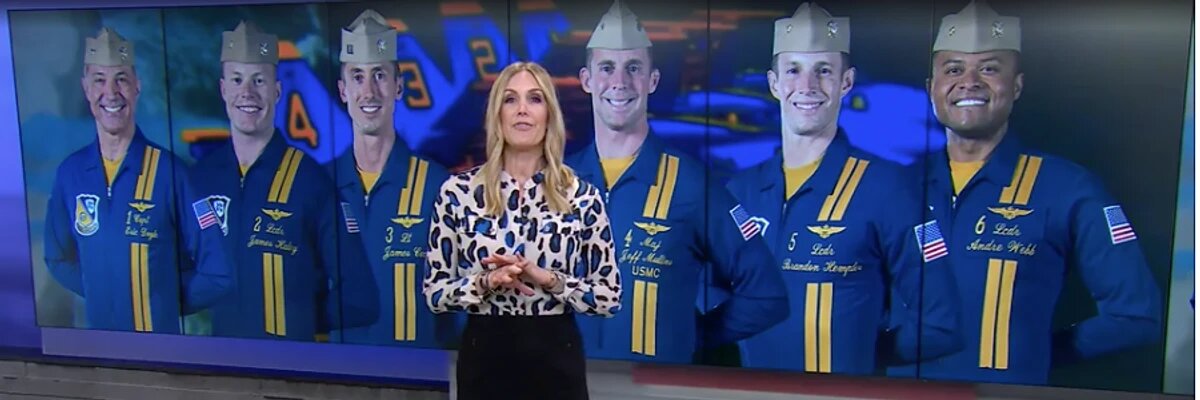
The Problem With the Blue Angels
Local news media celebrate a dangerous, expensive, military PR event without raising a single question or issue.
Each October, a couple of weeks before the faux frights of Halloween, the Bay Area is treated to a truly terrifying aerial bombardment. Air force jets shred and scream through the sky and dive-bomb in acrobatics that come perilously close to buildings, neighborhoods, and thousands of people.
In an era of worries about climate change, personal safety, and public spending, you’d think that the Navy’s Fleet Week and Blue Angels air show would be a tough sell. Yet, even as the event guzzles phenomenal amounts of fossil fuels and taxpayer dollars–and presents huge safety risks with its low urban flyovers and perilous maneuvers–the military celebration and public-relations stunt draws big cheering crowds and uncritical applause from mainstream media and politicians.
There’s no real doubt about what this is really about: In its annual budget, the Navy describes the Blue Angels as “a recruiting tool to increase public awareness of the US Navy.”
The Blue Angels pilots are immensely skillful, flying in airtight formations that put their jets within inches of each other (sometimes causing accidents and near-collisions). The Blue Angels are a great show — but at what cost, and to what end?
For all the “cool factor” of soaring jets, the Blue Angels create widespread fear, too. For one example, Michelle Celeste Malliett, a para-educator in San Francisco, told me: “I work in special education and when the blue angles fly overhead practicing, the class goes wild, in a bad way. They all cry. They get terrified.”
Others, including veterans and refugees from war zones have repeatedly reported being traumatized by the Blue Angels screaming and roaring overhead.
Several groups, including Code Pink and Veterans for Peace, will protest Fleet Week and the Blue Angels this Sunday, Oct. 13, with their 2ndannual Peace Flotilla in the Bay. The protest launches with a press conference at 10:30 am, at the Marina Bay Yacht Harbor, 1340 Marina Way South, in Richmond. The groups’ Peace Fleet Procession will protest from Noon to 4pm along the San Francisco shoreline.
For those more concerned about government spending than our climate crisis, consider the expenses that go into this entirely nonessential celebration of militarism.
According to numerous reports citing Navy budget figures, the Blue Angels shows–including training exercises and support–cost the taxpayers $35.5 million a year. Of course, in the grand scheme of fiscal things, that’s not a big chunk out of the $4.4 trillion US budget, or even of the Navy’s proposed $41.4 billion in spending for 2019. But it would buy an awful lot of shelter and meals for homeless people.
By one measure, the Navy could feed all homeless veterans in the US three meals a day for more than a month with the Blue Angels money (this is based on calculations by Newsweek on how many meals could be provided to homeless veterans for $10 million, the low-end cost estimate for President Trump’s inauguration rally).
The military newspaper, Stars and Stripes confirmed these costs in a story earlier this year, writing: “The aerial demonstration performances by the Navy’s Blue Angels and the Air Force’s Thunderbirds squadron had the biggest costs on this comparison list. The Blue Angels’ estimated cost was $36 million in fiscal year 2019, and the Thunderbirds’ estimated cost was $35 million in 2018.” According to Stars and Stripes, the costliest Fleet Week events in 2017 “were in Los Angeles at $1.6 million, San Francisco at $1.8 million, and New York at $2.5 million with the inclusion of fuel costs.”
If the Blue Angels money doesn’t sound like much to you, consider that this spending on militarism and PR is emblematic of our overall military spending madness, which devours more than half of all government spending. This chronic military-industrial complex not only feeds more “endless wars,” but also hamstrings efforts to combat poverty and other vital social justice initiatives.
This past year, the Navy requested a budget increase for the Blue Angels, explaining: “Increase for the Navy Flight Demonstration Team (Blue Angels) reflects 137 additional flight hours and associated cost for fuel, aviation depot level repairable parts, equipment maintenance, consumable supplies and materials, travel and the purchase of services to support 46 aerial demonstrations and media flights.”
Among those media flights was local television news anchor Heather Holmes, of KTVU Channel 2, who posted numerous tweets celebrating her flight, including these: “Still can’t get over my incredible ride with the @BlueAngels!!” and: “Reaaadddyyyy. Hit it! I share my experience flying with the @BlueAngels tonight at 10:30 on @KTVU. It’s as cool as you think it is!!” Holmes did not respond to requests for a response for this article.
These media celebrations of military displays are widespread, and portray tools of war as benign, “cool” machines–although they are designed to kill people.
The Blue Angels’ pollution and fossil fuel consumption should concern everyone. How much fuel are we talking about? More than 1,200 gallons per hour. That’s how much fossil fuel one Blue Angel jet burns in its acrobatic gyrations before cheering crowds below. According to some calculations, a fuel-efficient car could drive 48,000 miles (more than 15 cross-country trips) on that fuel. At roughly ten dollars a gallon (Pentagon purchasing rates for jet planes), that’s $72,000 an hour just for fuel, for six Blue Angel jets.
During the 2014 baseball All-Star Game in Minneapolis, the Navy dispatched some Blue Angels to scream through the sky during the end of the Star-Spangled Banner anthem. As one reporter described, “each of the multi-million-dollar fighter jets will consume about 500 gallons of fuel just to make the 30-minute round trip to and from Minneapolis.”
The airshows are just one moment of fossil fuel indulgence. As another writer uncovered, the pilots consume astronomical amounts of these climate-wrecking fuels in their thousands of hours of training for these PR shows: based on figures provided by the Blue Angels, “the 3,000 hours of training for the single Commanding Officer used up as many as 2,400,000 gallons of jet fuel just to qualify (3,000 hours X 800 gallons/hour)!”
These public-relations jets are part of what makes the US military the world’s largest consumer of fossil fuels. As scholars at Brown University’s Watson Institute showed in a 2019 study, the U.S. military “is the world’s largest institutional user of petroleum and correspondingly, the single largest producer of greenhouse gases (GHG) in the world…In 2017, for example, the Pentagon’s greenhouse gas emissions were greater than the greenhouse gas emissions of entire industrialized countries as Sweden or Denmark.”
Despite their remarkable skills, Blue Angels pilots make mistakes that can quickly turn deadly. In 2007, for instance, aBlue Angel F/A-18 Hornet jet “crashed during a performance in Beaufort, S.C., killing the pilot, injuring eight people and damaging several homes,”the San Francisco Chronicle reported.
In one fatal accident in 2016, the Navy blamed Capt. Jeff Kuss for numerous failures during his perilous descent from the sky: “Kuss made an error by starting the Split-S maneuver at a higher speed and below the required altitude, and investigators believe his other mistakes and oversights were likely due to tiredness. Officials are ordering changes that allow Blues pilots to more readily opt out of flying when they’re not feeling ready, are reviewing all air show maneuvers and are reworking future air show schedules to give fliers more rest time.”

This lack of rest time, and institutional failure to provide a substitute pilot, is endemic to the Blue Angels’ operations, according to testimony submitted by Vice Adm. Mike Shoemaker, head of Naval Air Forces. Shoemaker wrote, “Every other squadron in the fleet has the ability to find a substitute pilot to complete the mission or execute an alternative mission,” he wrote. “However, if one of the Blue Angels pilots is not ready, there are no other pilots who can readily cover their position for a show.”
This Navy and Blue Angels policy puts both pilots and the viewing public below–often numbering in the thousands–directly in harm’s way.
In April 2017, during a “rare joint flyover,” the U.S. Navy Blue Angels and the U.S. Air Force Thunderbirds “nearly ended in calamity when two of the Blue Angels’ F/A-18 Hornets momentarily touched while flying in formation causing minor damage to both aircraft,” The Aviationist reported. “The two aircraft landed without incident following the collision.” The potentially deadly collision was caused by “unexpected wake turbulence,” the Navy Times reported.
In 2016, military jet demonstration teams experienced at least four other accidents in the span of a single week, reports show. “The U.S. Air Force Thunderbirds, The U.S. Navy Blue Angels, the Swiss Patrouille Suisse team and the Russian Knights all suffered accidents during this time,” according to The Aviationist.
For these and other reasons, San Francisco Supervisor Chris Daly repeatedly tried to ban the Blue Angels and Fleet Week but was rebuffed every time. Given today’s ever-intensifying climate crisis, precious public monies, and public safety concerns, perhaps it’s time to put an end to these military PR shows.
Celebrating militarism, polluting the air, terrifying residents, and raiding millions from the public treasury–these are real issues. And the news media are ignoring them.


